

Social Media in Schools. There is something about Facebook, and all of social media, that makes it work especially well within a school community.

What began in the post-secondary realm has spread like wildfire throughout the world, but it has returned to academia on a younger scale. The social part of it is obvious, but for elementary school students and up the educational benefits are proving to be even more powerful than likes and pokes. Social media for schools: a guide to Twitter, Facebook and Pinterest. • For advice on e-safety in schools, click here The use of social media in education continues to be something of a hot topic with arguments both for and against.

So I carried out a small survey of 27 teaching professionals in order to create a baseline of understanding into the use (or not) of social networking in schools, and also any concerns over some of the e-safety risks. The full survey results can be found here. There are many uses of social media in education - below are just a few of the ways they can be effectively used. Facebook • Using Facebook as a 'broadcast' account. Inspiration: University of Gloucestershire - This is a Facebook Page from my old university.
Cambridge University - Another good example. Twitter • Twitter, like Facebook, is also being used as a broadcast account. The Teacher's Guide to Facebook. Facebook is the world's largest social network, reaching 1 billion active users at the beginning of October.
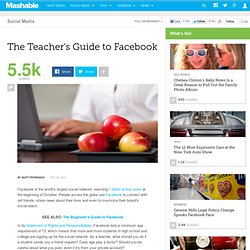
People across the globe use Facebook to connect with old friends, share news about their lives and even to maximize their brand's social reach. SEE ALSO: The Beginner's Guide to Facebook. Using Social Media: Guide for DEECD Employees. Cybersafety is a major concern facing schools.
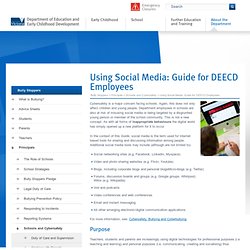
Again, this does not only affect children and young people. The 100 Best Web 2.0 Classroom Tools Chosen By You. One of the most popular posts on Edudemic in 2010 was The 35 Best Web 2.0 Classroom Tools Chosen By You and I felt it might be time for an update to that list for 2011.
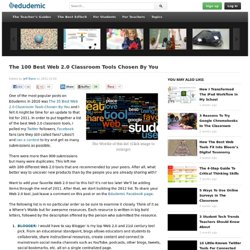
In order to put together a list of the best Web 2.0 classroom tools, I polled my Twitter followers, Facebook fans (are they still called fans? Likes?) And ran a contest to try and get as many submissions as possible. There were more than 900 submissions but many were duplicates. This left me with 100 different Web 2.0 tools that are recommended by your peers. Social Bookmarks. If you have ideas for using social bookmarks, examples of how you are using them, or other favorite bookmarking sites to share, go to--Social Bookmarks - Ideas to Share "Social bookmarking is a method for Internet users to store, organize, search, and manage bookmarks of web pages on the Internet with the help of metadata.
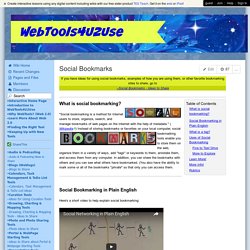
" ( Wikipedia) Instead of storing book marks or favorites on your local computer, social bookmarking tools enable you to store them on the web, organize them in a variety of ways, add "tags" or keywords to them, annotate them, and access them from any computer. In addition, you can share the bookmarks with others and you can see what others have bookmarked. (You also have the ability to mark some or all of the bookmarks "private" so that only you can access them. Here's a short video to help explain social bookmarking: Using Blogs to Integrate Technology in the Classroom, Education Up Close, Teaching Today, Glencoe Online. Using Blogs to Integrate Technology in the Classroom As the Internet becomes an increasingly pervasive and persistent influence in people's lives, the phenomenon of the blog stands out as a fine example of the way in which the Web enables individual participation in the marketplace of ideas.
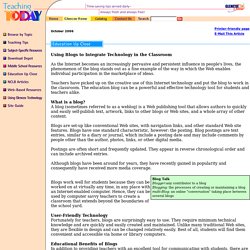
Teachers have picked up on the creative use of this Internet technology and put the blog to work in the classroom. The education blog can be a powerful and effective technology tool for students and teachers alike. What is a blog? The League of Extraordinary Librarians: SLJ’s latest tech survey shows that media specialists are leading the way. Meet the latest tech superheroes: school librarians.

According to School Library Journal’s 2012 School Technology Survey, media specialists are leading the charge to bring new media, mobile devices, social apps, and web-based technologies into our nation’s classrooms. So far, the results have been pretty impressive: 87 percent of school librarians report that they’re in charge of their library’s technology, with 60 percent adding that they’ve also introduced it into the classroom. Furthermore, 44 percent now serve on their school’s tech team, and in these budget-troubled times, when many library positions are on the line, that role may mean increased job security.
Top 100 Tools for Learning 2012. National Survey Shows District Use of Web 2.0 Technologies on the Rise and Improves Learning. Bakersfield, CA (PRWEB) March 28, 2011 Results of a new research survey indicate growing acceptance of Web 2.0 and collaborative technologies among school leaders and educators.
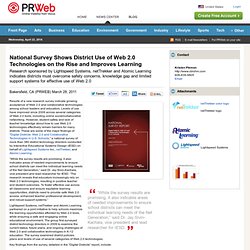
Judy O'Connell Presentations. Forging a Positive Cyber-Reputation: Who Are You? School Library Monthly/Volume XXVIII, Number 2/November Forging a Positive Cyber-Reputation: Who Are You?
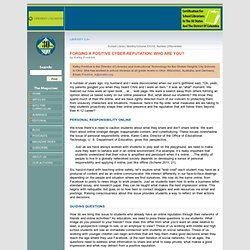
Student Inquiry and Web 2.0. School Library Monthly/Volume XXVI, Number 5/January 2010 Student Inquiry and Web 2.0 by Pam Berger Pam Berger is a library consultant, adjunct instructor at iSchool, Syracuse University, and editor of Information Searcher Newsletter. She is the author of Best Web 2.0 Tools for Teaching and Learning in the Digital World (Libraries Unlimited, forthcoming, spring, 2010). Email: pberger@infosearcher.com. Internet Safety Games - media center. Using Web 2.0 tools in the library. Web 2.0 applications and library & information services. By Karen Bonanno In the last half of 2010 I set up a survey to collect information on what Web 2.0 applications were being used by school libraries for their library & information services. The demographic background of the respondents (teacher-librarians and librarian). Survey Results: Web 2.0 in Schools. May 26, 2011 As part of Anseo.net’s competition to win a HD Flip Cam, participants answered some questions about the Web 2.0 tools that they use in school and at home.
In this article, we’ll examine the results and explore some of the reasons behind the results. It’s worth pointing out that the people who probably took the survey are IT literate and probably have some form of interest in ICT in education. There were 152 responses to the survey which asked the following questions: